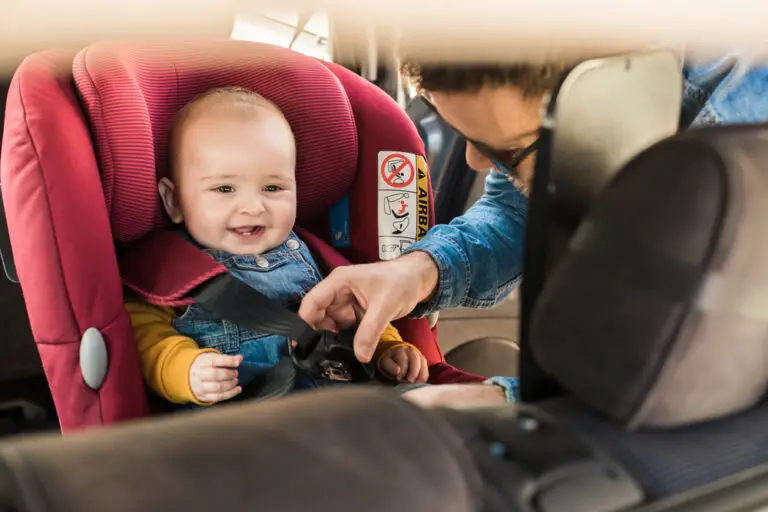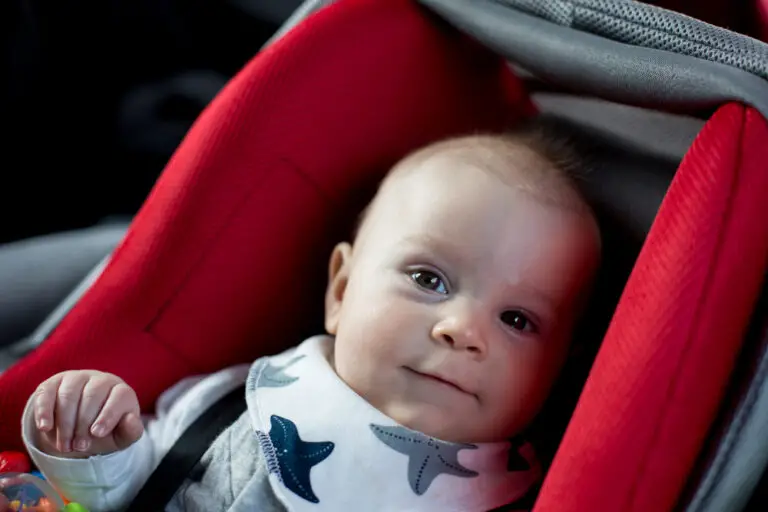New York Car Seat Laws 2024 (Rear, Forward & Booster)

New York car seat laws require all children below 8 years of age to ride in the prescribed child safety restraint systems.
These include rear-facing, forward-facing, and booster seats. Children who have a medical condition and cannot use child restraint are exempt. A violation of the law can result in a fine.
Disclaimer: This content does not constitute legal advice. It is solely for informational purposes. Always check the original source of the law for the latest version.
- NY Rear-Facing Seat Law
- NY Forward-Facing Seat Law
- NY Booster Seat Law
- NY Child Front Seat Law
- NY Child Seat Belt Law
- NY Taxi Child Seat Law
- NY Ridesharing Seat Law
- NY Child Seat Repl. Law
- Leaving Child in Car in NY
- Choosing a Child Seat in NY
- Seat Installation Help in NY
New York Car Seat Laws
New York Rear-Facing Car Seat Law
According to the rear-facing car seat law in New York, all children under the age of 2 years must be restrained in a rear-facing car seat. (1)
The New York Department of Motor Vehicles (NY DMV) recommends an infant rear-facing seat. (2) It must always be placed in the back seat of the vehicle and never in front of a passenger-side airbag.
The rear-facing car seat age in New York is 2 years. But it is better for the child to ride rear-facing for as long as possible. Once they outgrow the upper height and weight limits prescribed by the manufacturer, they can move to a forward-facing seat.
A violation of New York rear-facing child seat law carries a fine of a minimum $25 and maximum $100.
Age: Newborn to 2 years
Penalty: Minimum $25, maximum $100
New York Forward-Facing Car Seat Law
According to the forward-facing car seat law in New York, children under 4 years of age and weighing less than 40 pounds, who have outgrown their rear-facing seats, must be secured in a forward-facing car seat. (1) This also applies when they are being transported in school buses.
The forward-facing car seat age in New York is 4 years and younger. But children should continue riding in this seat till they reach the maximum height and weight limits prescribed by the seat’s manufacturer. Those who have a physical condition that disables them from using the seat are exempt. They must carry a written statement from a licensed physician to that effect.
Disobeying New York’s forward-facing child seat law carries a penalty of a minimum $20 and a maximum $100.
Age: Up to 4 years
Weight: Less than 40 pounds
Penalty: Minimum $25, maximum $100
New York Booster Seat Law
According to the child booster seat law in New York, all children between the ages of 4 and 8 years, weighing less than 100 pounds and shorter than 4’9” have to be secured in a belt-positioning booster seat system. (1) This can be a high back or backless booster seat. Only those who have a physical disability are exempt.
The booster seat age in New York is 4 to 8 years. Most booster seats can accommodate a weight of 40-80 pounds. (2) The National Highway Transport Safety Administration (NHTSA) recommends keeping your child in a booster seat till they reach the height of 4’9.” That is when a seat belt can fit a child properly.
Not following these New York booster seat requirements carry a fine of a minimum $25 and a maximum $100.
Age: 4 to 8 years
Height: Shorter than 4’9”
Weight: Less than 100 pounds
Penalty: Minimum $25, maximum $100
New York Child Front Seat Law
According to the child front seat law in New York, all children under the age of 8 years must be restrained in an appropriate child safety system as per their height and weight requirements. Those between 8 to 16 years must be restrained by a seat belt. (1)
A specific front seat age in New York is absent as New York state law does not prohibit kids from traveling in the front seat.
However, it is a dangerous practice as the airbags can cause serious injuries to children. (2) The American Academy of Pediatrics (AAP) recommends that children sit in the back seat till at least 13 years of age.
A violation of these child seat requirements in New York carries a fine ranging from $25 to $100.
Age: Recommended – 13+ years
Penalty: Minimum $25, maximum $100
New York Child Seat Belt Law
According to the child seat belt law in New York, all children between the ages of 8 and 16 years must wear a properly adjusted and fastened adult safety belt, whether they are in the front seat or the backseat.
Those younger than 8 years but who are taller than 4’9” and/or weigh more than 100 pounds are also required to wear a seat belt. (1) This also applies when they are traveling in taxis.
Seat belt rules in New York do not apply to children who have a physical disability. A licensed physician must certify the nature of the disability and why they recommend not wearing a seat belt.
A violation of any of the requirements of New York children’s seat belt law carries a maximum fine of $50.
Age: 8 to 16 years
Height: 4’9” or taller
Weight: 100+ pounds
Penalty: Maximum $50
New York Taxi Child Seat Law
According to the taxi child seat law in New York, taxis are exempt from having a child restraint system. (1) They are not required to have a car seat for a child passenger. The driver cannot be held responsible.
In this case, we recommend that you, as parents and caregivers, arrange an appropriate taxi child seat in New York. Depending on the child’s age and height, you can select a rear-facing, forward-facing, or a booster car seat. These seats should comply with New York child seat laws and meet federal safety standards.
When installing the car seat in a taxi, it is your responsibility as a caregiver to ensure that it is securely fixed. You can refer to the car seat manual for proper installation.
New York Ridesharing Child Seat Law
The ridesharing child seat law in New York is unclear. While car seat laws in New York require all children under 8 years old to be secured in the prescribed child restraint safety systems, it does not mention ridesharing services.
However, Uber offers the option of a car seat in New York City. Similarly, Lyft also allows parents to choose a car seat for an additional fee. But these options are only available in New York City.
The law places the responsibility of a car seat on the person operating the vehicle. In such a scenario, it is best for either the driver or the parent/caregivers to provide an appropriate child seat. Otherwise, they may expose themselves to a fine of a minimum of $25 and a maximum of $100. (1)
New York Child Seat Replacement Law
There is no express child seat replacement law in New York. However, the NHTSA recommends child seat replacement after an accident.
In case of a moderate or severe accident in New York, you must immediately replace the child safety seat. It may have defects that are not easily visible and can pose a risk.
In case of a low-impact accident, there is no urgent need to replace the car seat. A low-impact crash is where no passenger sustains injuries, the airbags didn’t deploy, there was no damage to the car seat, and the vehicle could be driven away from the crash site.
You must also replace the car seat after it has passed its expiry date prescribed by the manufacturer or your child has outgrown it.
Leaving Child in the Car in New York
There is no specific law on leaving a child in a vehicle in New York. However, the AAP has highlighted the dangers of leaving a child unattended in a vehicle. They may suffer heatstroke, set the vehicle in motion, or get kidnapped or trapped in the vehicle.
Many children have suffered from heat stroke inside vehicles. The temperature inside the vehicle can rise quickly. Since children’s bodies heat up faster than adults, it can cause severe brain injury or even death.
The New York Office of Children and Family Services warns against leaving a child in the car in New York even for a minute. If the child is injured, the adult responsible for the act can face serious legal consequences such as child neglect.
Choosing a Child Car Seat in New York
You can refer to NHTSA recommendations when choosing a car seat in New York. Children below 2 years old should ride in a rear-facing seat. For toddlers and young children, a forward-facing seat with a harness is the best car seat to use in New York.
Once children outgrow the forward-facing seat, they should travel in a booster seat. You can choose either a backless or a high-back booster seat. A versatile all-in-one seat may be the best booster seat to use in New York.
You can also check the NY DMV website to buy the appropriate child passenger safety seats in New York.
Car Seat Installation Help in New York
Whenever you are installing a car seat, you must pay attention to the manufacturer’s instructions. To ensure that you have correctly installed it, you should get the seat inspected by a certified child passenger safety (CPS) technician. Following are some of the stations where you can get them checked:
- Monroe County Car Seat Installation Checks Locations
- Town of Hyde Park Police
- Oswego County Health Department
- Office of the Ulster County Sheriff
- Albany Medical College has a list of locations offering car seat checks.
- Bethlehem Police Department Traffic Safety Unit
For more locations, you can check the website of the Governor’s Traffic Safety Committee.
New York Car Seat Safety Resources
- New York State Department of Motor Vehicles (NY DMV): The official DMV website provides recommendations on how to select an appropriate car seat for your child.
- New York State Department of Health: The official website of the Department of Health, it contains information about injury prevention in children. The resources are aimed at parents/caregivers and are divided according to age groups.
- Governor’s Traffic Safety Committee: It coordinates traffic safety activities in New York and contains information about New York car seat regulations, upcoming car seat check events and other useful resources.
- Mount Sinai: The Mount Sinai Health System provides exceptional medical care through a network of member hospitals.
FAQ
How long should a child ride in a rear-facing car seat in New York?
Under the law, a child should ride in a rear-facing car seat till the age of 2 years. Ideally, they should stay in it till they outgrow it.
Can you put a rear-facing car seat in the front seat in New York?
Yes, you can put a rear-facing car seat in the front seat. New York law does not prohibit it. But the passenger-side airbag must be deactivated.
Can you put a rear-facing car seat in the middle rear seat in New York?
Yes, you can put a rear-facing car seat in the middle seat if your vehicle has lower anchors for the middle seat that can hold the car seat tightly.
When can a baby face forward in a car seat in New York?
A baby can face forward once they turn 2 years old. They can also face forward when they surpass the maximum height and weight limits of their rear-facing seat.
How old for a booster seat in New York?
A child between the ages of 4 and 8 years old and shorter than 4’9” inches can ride in a booster seat if they have outgrown their forward-facing seat.
When to use a backless booster seat in New York?
You can use a backless booster seat only if your vehicle seat has a head rest and the child’s ears are not higher than the seat back.
When can a child sit in the front seat in New York?
There is nothing specific in the law. A child can sit in the front seat provided they are secured as per federal safety standards in an appropriate car seat.
When can a child sit in the front seat with a booster in New York?
The law does not prohibit children from sitting in the front seat with a booster. However, the backseat is the safest place for children in a vehicle.
When can a child stop using a booster seat in New York?
A child can stop using a booster seat once they turn 8 or are at least 4’9” inches tall. They then have to use the seatbelt.
When to switch from 5 point harness to a seat belt in New York?
A child can switch from a 5-point harness to a seat belt once they outgrow the harness. They can then move to a belt-positioning booster seat.
When can a child use a regular seat belt in New York?
A child can use a regular seat belt in New York once they turn 8 years old or reach at least 4’9” inches in height.
Do you need a car seat in a taxi in New York?
No, taxis are not required to have a car seat. But it is best if you carry your child seat and install it in the taxi.
Do you need a car seat in a Uber in New York?
The law is unclear on this issue. But either the caregiver or the driver should provide an appropriate car seat to ensure the child’s safety.
Do you need a car seat in a Lyft in New York?
The law is not clear on this issue. But either the caregiver or the driver should provide an appropriate car seat to ensure the child’s safety.

Rishima Rawat
Rishima Rawat is a lawyer and legal writer with over six years of writing and legal experience. She earned her LLB degree from the West Bengal National University of Juridical Sciences, Kolkata. With a passion for child safety, she’s written extensively about the U.S. car seat laws in ParentingMode. She collaborates with businesses and law firms globally, enhancing their online content. Her insights are also published in legal journals like RGNUL, NLIU, and RMLNLU Law Review. Committed to the cause of education, she has volunteered with IDIA, which helps underprivileged children in India to access legal education. She has also worked with Enhelion Knowledge Ventures, a leading legal ed-tech platform in India that provides students with affordable courses in law. Fluent in English and Hindi with elementary proficiency in Spanish, Rishima combines her legal expertise with a dedication to child safety.






